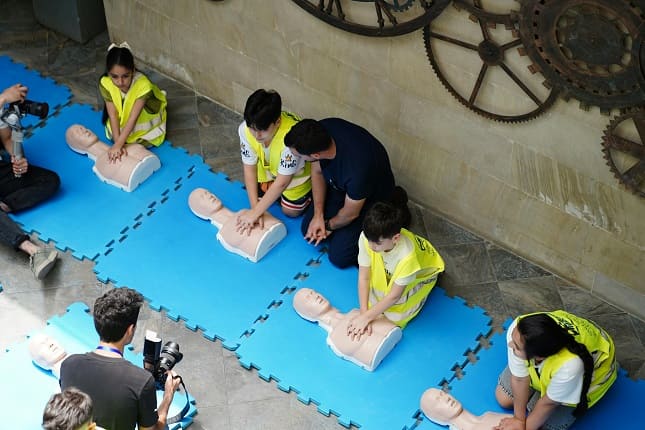What if you are in the hospital and your colleague collapses suddenly? Just moments later, you see a child choking on food. Do you have enough skills to help both people in distress? If not, then you need to upskill yourself as soon as possible. According to the American Heart Association, over 73.4% of out-of-hospital cardiac arrests happen in homes and public places.
Only immediate cardiopulmonary resuscitation (CPR) can increase the victim’s chances of survival in such cases. However, you can learn about these techniques only by enrolling in a Basic Life Support (BLS) course that includes both adult and pediatric life support. This ensures you can easily handle emergencies related to all age groups. Let’s learn more about a BLS course that includes both adult and pediatric life support below.
What Is a BLS Course?
A Basic Life Support (BLS) course is designed to prepare individuals to handle life-threatening emergencies like cardiac arrest, respiratory failure, and airway obstruction. Most BLS programs cover the fundamentals of CPR and AED usage. However, a few other courses also specialize in age-specific life support protocols. These courses cover the key differences between adult, child, and infant responses. You can easily provide correct care depending on the patient’s age by enrolling in such courses.
Adult- and Pediatric-Specific CPR Techniques
CPR methods may vary across age groups. Adults often need full-depth chest compressions using both hands. Conversely, infants may need gentle compressions with two fingers or thumbs. A BLS course helps you understand the differences and when to apply each correctly. This increases the victim’s chances of a successful resuscitation.
Use of an AED on Different Age Groups
The Automated External Defibrillator (AED) is a key component of any emergency response. A quality BLS course teaches how to use standard AED pads for adults and pediatric pads or energy-reducing systems for children under 8. These distinctions ensure that the shock delivered is safe and effective for the patient’s body size.
Relief of Choking for all Age Groups
Choking is a leading cause of death in young children but it can also occur in adults. BLS training includes techniques such as abdominal thrusts for adults and children and back blows with chest compressions for infants. These methods vary in execution and intensity, and hands-on training allows you to practice and perfect them.
Why Adult and Pediatric Life Support Matters
Many emergencies occur unexpectedly and can involve people of any age. Having the skills to respond to both adult and pediatric patients not only increases your readiness but also makes you more valuable in both personal and professional settings. A dual-focused BLS course ensures you’re not caught unprepared in any situation.
Increased Flexibility in Emergencies
Emergencies don’t discriminate by age. A child choking at daycare or an adult suffering cardiac arrest at the gym both require quick action. BLS training that covers all age groups prepares you for any eventuality, reducing hesitation and confusion during critical moments.
Essential for Healthcare and Non-healthcare Professionals
While BLS is mandatory for medical staff, it’s also vital for teachers, security personnel, coaches, and even parents. Having comprehensive training ensures you’re equipped to help whether you’re in a hospital or at home. In many cases, the first responder isn’t a doctor—it’s a bystander who knows what to do.
Supports Better Community Health Outcomes
Communities with more BLS-certified individuals experience higher survival rates in emergencies. When more people are trained across age spectrums, response times improve, and outcomes are more favorable. You contribute to a safer environment for everyone by learning both adult and pediatric support.
Key Skills Taught in a BLS Course Covering All Age Groups
This type of BLS course includes various life-saving techniques for adults, children, and infants. These are not generic skills because each one is age-specific and practiced in real-life scenarios to build muscle memory and confidence.
High-quality Chest Compressions
You’ll learn how to maintain the correct compression depth and rate, which is crucial for effective CPR. For adults, compressions must be at least 2 inches deep; for children, about 2 inches; and for infants, 1.5 inches deep. The course emphasizes maintaining a rate of 100–120 compressions per minute while allowing full chest recoil.
Rescue Breathing and Ventilation Techniques
Rescue breaths are different depending on the patient’s age and size. The course teaches mouth-to-mouth breathing for adults, mouth-to-mask breathing for children, and mouth-to-nose breathing for infants. It also trains you to deliver breaths over one second and recognize visible chest rises, which confirms effectiveness.
AED Setup and Usage for Different Age Groups
You’ll practice how to correctly place AED pads and follow prompts for adults and children. The training explains when to use pediatric pads or a manual adjustment to reduce energy levels for small children. You also learn what to do if pediatric equipment isn’t available, ensuring you’re never stuck without a solution.
Managing Choking Emergencies
The course includes age-appropriate techniques for relieving foreign-body airway obstructions. Adults and older children require abdominal thrusts, while infants need back slaps and chest compressions. Simulated practice helps you understand the correct force and positioning to apply in each case.
Who Should Take This BLS Course?
Anyone who could be faced with a medical emergency involving any age group should strongly consider taking this course. It’s particularly important for those in roles where they interact with the public, children, or vulnerable adults regularly.
Healthcare Workers and First Responders
EMTs, nurses, doctors, and paramedics must be proficient in adult and pediatric life support. BLS certification is often a job requirement and is crucial for rapid, age-appropriate care in hospitals or ambulances.
Teachers, Coaches, and Childcare Providers
Educators and coaches are often the first line of response when a child collapses at school or on the field. BLS training prepares them for real-world emergencies involving young children and teens.
Parents, Babysitters, and Caregivers
Infants and young children can quickly go from healthy to critical in seconds. Parents and caregivers benefit immensely from knowing how to perform CPR or clear a blocked airway while waiting for emergency services to arrive.
Corporate Employees and Security Staff
Many businesses are now investing in workplace safety. Having staff certified in BLS improves workplace readiness and can save lives during critical health episodes involving clients or colleagues.
What to Expect from a Dual-Focused BLS Course
You must understand the BLS course structure before setting any realistic expectations. These interactive, hands-on courses are focused on real-life applications rather than just theory.
Blended Learning Options
Many providers offer a combination of online modules and in-person practice sessions. You can easily grasp the theoretical concepts at your own pace. Later, after learning everything, you can apply them in a guided classroom setting.
Practice with Adult, Child, and Infant manikins
The hands-on portion involves practicing compressions and ventilations on realistic mannequins of various sizes. This builds confidence and helps you refine techniques based on feedback from instructors and smart devices.
Certification and Renewal Every Two Years
Upon passing the course, you’ll receive a BLS Provider certification card valid for two years. Renewal is necessary to keep skills fresh and stay updated with new protocols or guidelines from medical authorities.
Enroll in a BLS Course of Your Choice Today!
Emergencies can strike anywhere and affect anyone, regardless of age. A BLS course that includes both adult and pediatric life support equips you with the critical skills to respond effectively, no matter the situation. From performing CPR to using an AED or managing a choking incident, the knowledge you gain could save a life.
Whether you’re a healthcare professional, teacher, or parent, this comprehensive BLS training is an investment in safety for your family, your workplace, and your community. Don’t wait for an emergency to wish you had the skills. Get certified in adult or pediatric CPR care by enrolling in an accredited course.









































